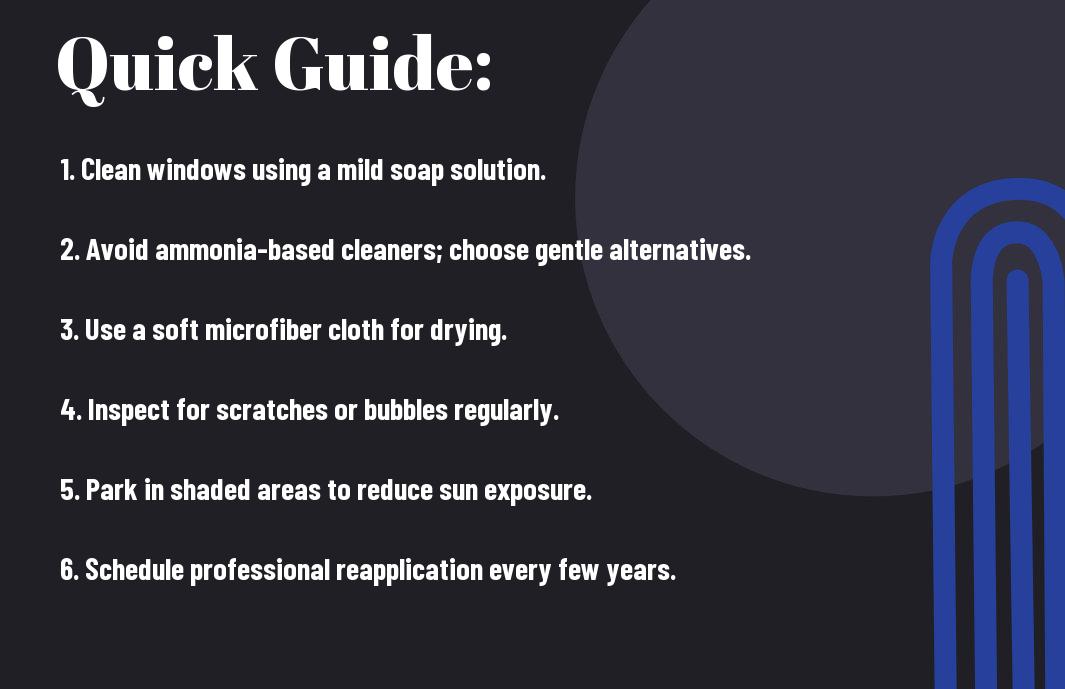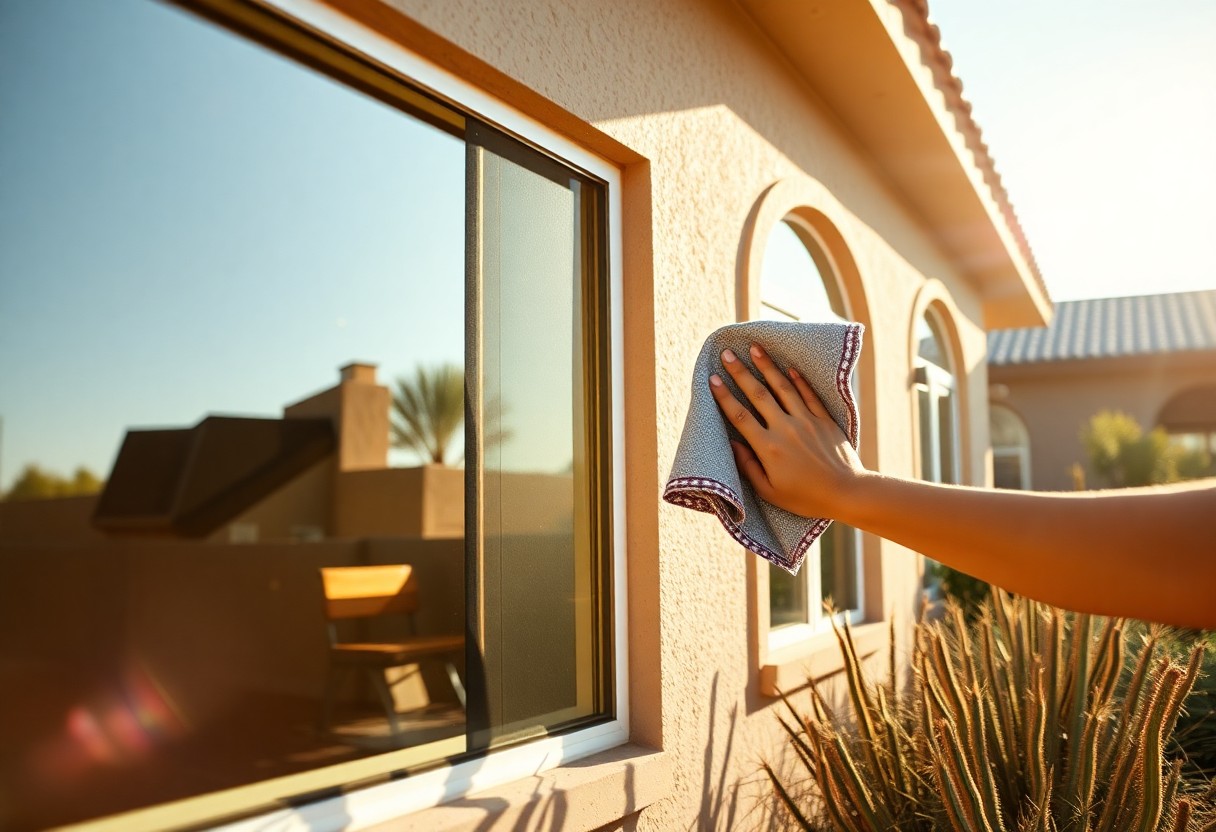This guide offers you vital insights on how to preserve your window tinting in Arizona’s harsh climate. With extreme sunlight and temperatures, ensuring your tinting remains in optimal condition is vital for protecting your car’s interior and enhancing your driving experience. You’ll learn effective maintenance tips that will help you avoid costly repairs and ensure longevity. For additional expert advice, check out the Top 6 Tips on Window Tinting and It’s Benefits.
Key Takeaways:
- Regular Cleaning: Keep your window tinting clear by using a gentle cleaner and a soft cloth to avoid scratching the film.
- UV Protection: Ensure your tint has a high UV protection level to safeguard your vehicle’s interior from sun damage.
- Professional Installation: Consider having your window tint professionally applied to ensure optimal durability and compliance with Arizona regulations.
Understanding Window Tinting
The world of window tinting is multifaceted, especially in a sun-drenched state like Arizona. Understanding the basics of window tinting can help you make informed decisions for your vehicle and home. Window tinting not only enhances your vehicle’s aesthetic appeal but also provides several practical benefits, including UV protection and temperature regulation. It’s vital to know the types of window films available and how they perform under Arizona’s intense sunlight.
Types of Window Tinting
Window films come in various types, each designed to serve specific needs. Here are some of the most common types:
| Dyed Window Film | Affects appearance and reduces glare. |
| Metalized Window Film | Provides durability and heat resistance. |
| Ceramic Window Film | Blocks UV rays without interfering with electronics. |
| Hybrid Window Film | Combines benefits of dyed and metalized films. |
| Infrared Rejecting Film | Specifically designed to block heat. |
Recognizing the differences in these films can help you select the right option based on your needs and preferences.
Factors Affecting Window Tinting Durability
There’s a lot to consider when it comes to the durability of your window tinting. The quality of the film, the installation process, and environmental factors such as sunlight exposure play significant roles in how well your tint lasts. High-quality films typically provide better longevity and performance, ensuring that you enjoy the benefits for years to come.
- Quality of the film
- Installation method
- Climate and weather conditions
- Exposure to UV rays
- Maintenance practices
Perceiving the importance of these factors can lead to a more satisfying experience with your window tinting.
Tinting durability can also be influenced by regular maintenance and care. This includes cleaning methods and the products you use on your tinted windows. Using harsh chemicals or improper techniques can damage the film and diminish its lifespan. Your attention to these details is vital for maintaining the protective attributes of your tint.
- Cleaning methods
- Environmental influences
- Regular inspections
- Improper installation signs
- Manufacturer’s recommendations
Perceiving how your actions affect window tint durability can help you avoid common pitfalls.
Pros and Cons of Different Tint Types
You might be wondering what the best type of window tint is for your vehicle or home. Knowing the benefits and drawbacks of each type can guide you in making a decision that aligns with your needs. Below is a comparison of the prevalent tint types, showcasing their respective pros and cons.
Pros and Cons of Different Tint Types
| Dyed Window Film | Inexpensive, adds aesthetic appeal. |
| Metalized Window Film | Highly durable, reduces glare. |
| Ceramic Window Film | Excellent heat rejection without interference. |
| Hybrid Window Film | Combines the best of two worlds. |
| Infrared Rejecting Film | Specifically designed to block heat effectively. |
Factors affecting your decision may include initial costs versus long-term benefits, durability, and specific applications. As you weigh the pros and cons of different tint types, you should consider how they meet your unique needs and lifestyle.
Understanding these details about window tinting can empower you to make informed decisions that contribute to your comfort and safety in Arizona’s harsh climate. Keep in mind that the right choice can optimize benefits while minimizing drawbacks, ensuring that your investment brings satisfaction for years to come.

Tips for Maintaining Window Tinting
Clearly, maintaining your window tinting is imperative to preserving its functionality and appearance. If you want your window tint to last for years, consider the following tips:
- Use a gentle detergent solution to clean your tinted windows.
- Avoid using abrasive materials that can scratch the surface of the tint.
- Keep your car parked in a shaded area whenever possible to reduce heat exposure.
- Avoid rolling down your windows for at least three to five days after installation.
- Consult a professional if you notice any bubbling or peeling.
Any proactive maintenance efforts you undertake will ensure that your window tint remains effective and visually appealing.
Best Cleaning Products for Window Tint
Tint maintenance starts with using the right cleaning products. You should always opt for a mild, non-ammonia based cleaner to avoid damaging the window tint film. Look for products specifically labeled for use on tinted windows or a simple mix of soap and water, which is a safe and effective alternative. Avoid any cleaners with harsh chemicals or abrasives.
Additionally, microfiber cloths are ideal for cleaning tinted windows. Their soft fibers are non-abrasive and won’t scratch the film. Always ensure that the cloth is clean and dry before use to prevent any potential damage. By choosing appropriate cleaning supplies, you extend the life of your window tint significantly.
Recommended Cleaning Techniques
Any time you clean your tinted windows, it’s imperative to use the right techniques. Start by gently wiping the surface with a microfiber cloth dampened in your chosen cleaning solution. Use soft, circular motions to lift any dirt or grime without applying excessive pressure. This method minimizes the risk of ruining the tint due to harsh scrubbing.
Also, it’s best to work on the windows one at a time to ensure thorough cleaning. Always dry the window with a separate microfiber cloth afterward to prevent streaks. Keeping the film free of debris not only makes it look better but also keeps it functioning properly.
To maintain your window tint, make it a habit to clean your windows regularly, ideally once a month. Frequent cleaning prevents dirt buildup and ensures that you can quickly correct any issues before they complicate. Your tinted windows will thank you for the attention.
Frequency of Maintenance
Window tinting requires consistent maintenance to ensure lasting performance. While many people think that tinted windows are maintenance-free, they actually need periodic attention. You should aim to check the condition of your tint at least every six months. Look for signs of bubbling, peeling, or discoloration, which might indicate a need for professional assessment.
Additionally, consider the environmental factors your vehicle experiences. For instance, if you live in an area with intense sun exposure, you may need to clean your windows more often to maintain visibility and prevent damage to the film. Proper maintenance can add years to the life of your window tint.
Window maintenance is not just about cleaning; it is also about protecting your investment. A well-maintained window tint not only enhances the aesthetic appeal of your vehicle but also contributes to temperature regulation inside, making your driving experience more comfortable.

Step-by-Step Guide to Tint Maintenance
Many homeowners and car enthusiasts in Arizona enjoy the benefits of window tinting, but maintaining it properly is imperative for longevity and appearance. Follow this step-by-step guide to ensure your window tint stays in excellent condition.
| Maintenance Task | Description |
| Initial Inspection of Window Tint | Check for any imperfections, discoloration, or damage to your window tint. |
| Cleaning the Window Tint | Use appropriate cleaning solutions to keep your tint clear and free of dust. |
| Repairing Minor Bubbles and Peeling | Treat small bubbles and peeling edges to maintain appearance. |
| When to Seek Professional Help | Identify signs that require professional intervention for your tint. |
Initial Inspection of Window Tint
While caring for your window tint, the first step is conduct an initial inspection. Look for signs of wear, such as bubbles, scratches, or discoloration. Proper inspection can help you catch minor issues before they escalate into more significant problems.
You should also check the edges of the tint. If you notice any peeling or lifting, it could lead to further deterioration if left unattended. Be thorough in your examination, as identifying these problems early can save you time and money down the line.
Cleaning the Window Tint
Clearly, keeping your window tint clean is vital for both aesthetics and functionality. Use a non-abrasive cleaner and a soft cloth to avoid scratching the film. Avoid using ammonia-based products, which can damage the tint over time. Instead, opt for pH-balanced solutions that are safe for window films.
Additionally, always clean your tinted windows by wiping gently in a circular motion to lift dirt without putting too much pressure on the film. Frequent cleaning can help maintain visibility, and it can also prevent build-up that might damage the tint.
Initial maintenance for tinted windows involves regular cleaning, which can significantly improve your viewing experience and keep your tint looking fresh.
Repairing Minor Bubbles and Peeling
Minor bubbles in your window tint can often be repaired with a simple technique. Wet the area around the bubble and use a credit card or a soft object to gently push the air out. This technique helps restore the appearance of your tint with minimal effort. If you encounter peeling, apply a heat source like a hairdryer to the affected area, and then press the edge back firmly with your fingers.
If the bubble or peeling persists after these attempts, it may require more specialized products or professional assistance. Staying proactive can help you avoid significant repairs down the line.
Tint maintenance involves understanding how to address minor issues like bubbles and peeling effectively and in a timely manner.
When to Seek Professional Help
Tinting issues can sometimes go beyond what you can manage personally, so it’s imperative to recognize when to seek professional help. If you notice extensive bubbling, cracks, or fading that cleaning or minor repairs cannot rectify, it’s time to consult a professional. They possess the experience and tools necessary to address complex problems safely and effectively.
Moreover, if you suspect that the tint installation was faulty, a professional can evaluate and potentially replace the tint as needed. Addressing these problems promptly ensures you maintain the benefits of your window tint.
Peeling or extensive damage may not always be fixable at home, so ensuring you know when to call for assistance is vital for proper maintenance.
Environmental Factors in Arizona
Despite the aesthetic appeal and practicality of window tinting, you must consider various environmental factors specific to Arizona when maintaining your investment. The intense sun, seasonal changes, and fluctuating temperatures can significantly impact the longevity and effectiveness of your tint. Here are some key considerations:
- Intensity of the Arizona sun can lead to fading.
- High temperatures can cause adhesive failure.
- Dust and debris accumulation can affect visibility.
- Seasonal temperature shifts can impact the tint’s integrity.
- UV exposure can cause skin damage and interior fading.
Impact of Arizona Sun on Window Tint
With the blazing Arizona sun, window tinting is more than a cosmetic upgrade; it’s a necessary shield against harmful UV rays. Prolonged exposure to ultra-violet radiation can cause both the tint film and the underlying materials of your vehicle or home to degrade. Over time, this can lead to significant fading, not just of the tint itself, but also of the upholstery and interior surfaces of your vehicle or home. Thus, the quality of your tint plays a key role in protecting against such damage.
Moreover, choosing a high-quality window tint can minimize heat build-up and enhance your comfort. Investing in a professional installation ensures that the tint adheres properly and holds up against the relentless Arizona sun. With proper care and periodic inspections, you can help extend the life of your tint, making it an invaluable asset for your vehicle or home.
Seasonal Considerations for Tint Care
Considerations in Arizona’s unique climate require you to stay vigilant regarding the maintenance of your window tint throughout different seasons. The extreme heat in summer can exacerbate issues like bubbling or peeling if your tint is not properly applied or if it’s low quality. Meanwhile, cooler winter temperatures might cause unnecessary expansion and contraction of the tint film, leading to cracks or separations. Therefore, continual monitoring is vital during these seasonal transitions.
Seasonal weather patterns can also bring additional challenges, such as dirt and debris. During monsoon season, heavy rains and dust can accumulate on your tinted windows, leading to reduced visibility and aesthetic appeal. Regular cleaning and maintenance can prevent long-term damage and keep your windows looking their best.
Temperature Fluctuations and Tint Integrity
One of the most significant challenges for window tinting in Arizona is the extreme fluctuations in temperature throughout the year. The following table outlines the potential effects of temperature changes on your window tint:
Impact of Temperature Fluctuations on Tint
| High Temperatures | Effects |
|---|---|
| Bubbling or peeling | Weakens adhesive bonds over time. |
| Fading | Decreases visibility and aesthetics. |
To protect your window tint, focus on how temperature fluctuations can influence its durability. If you notice any irregularities in the tint’s surface, such as bubbling or discoloration, it may be time to reassess its quality or installation method.
To further enhance the longevity of your window tint, using a high-grade film specifically designed for extreme temperatures can make a significant difference. Proper installation techniques also play a role in maintaining the integrity of your tint against the harsh desert environment. By choosing the right materials and caring for your tints, you can enjoy both the aesthetic and functional benefits for years to come.
Common Issues with Window Tint
Not all window tinting is created equal, and it’s imperative to be aware of the common issues that can arise, especially in the extreme conditions found in Arizona. By understanding these problems, you can take appropriate measures to maintain your tint and extend its lifespan. In this section, we will address the most prevalent concerns homeowners face with window films.
Fading and Discoloration
You may notice that your window tint gradually loses its luster over time, becoming dull or discolored. This phenomenon is particularly prevalent in high UV environments like Arizona. Exposure to constant sunlight can cause the tint material to break down, leading to an unsightly appearance that detracts from the overall aesthetics of your property.
Additionally, fading can significantly impact the functional benefits of your window film. If the tint loses its color, it may also lose its ability to reject heat and harmful UV rays effectively. Regularly cleaning your windows with gentle solutions, rather than harsh chemicals, can help slow down this process and keep your tint looking fresh and vibrant.
Bubbling and Cracking
To ensure the longevity of your window tint, it’s imperative to keep an eye out for signs of bubbling and cracking. These issues often stem from improper installation or exposure to extreme heat, which can cause the adhesive to weaken. Bubbles appear as small pockets of air trapped between the glass and the film, while crack lines can significantly detract from the overall clarity and effectiveness of your tint.
Understanding the underlying causes can be helpful. Bubbles might form if dust or debris is trapped during installation, and high temperatures can exacerbate the situation. Promptly addressing these issues is crucial, as ignoring them could lead to a complete replacement of the tint film.
Poor Adhesion to Glass
On rare occasions, you may encounter poor adhesion of your window tint to the glass surface. This can manifest as peeling edges or areas where the film looks like it’s lifting off the glass. Such problems can be attributed to inadequate cleaning of the glass before installation or the use of subpar adhesive materials. In Arizona’s dry, hot climate, the risk of poor adhesion increases, making it vital to choose a reputable installer.
Issues like this may not only be frustrating; they can also result in decreased performance of the window film. A poorly adhered film might not provide adequate insulation from heat or UV rays. Therefore, ensuring proper installation from the start is invaluable in preventing these issues from occurring.
Frequently Asked Questions
Your decision to install window tint can lead to questions about maintenance and longevity. In this section, we will tackle some frequently asked questions to help you get the most out of your window tinting investment.
How Long Does Window Tint Last?
With proper care and maintenance, window tint can last anywhere from 5 to 10 years. The longevity of your tint depends on various factors including the quality of the film you chose, the installation, and environmental conditions. In Arizona’s harsh climate, intense sunlight and heat can take a toll on your tint, making proper maintenance even more important to preserve its lifespan.
Regular cleaning using the right products is important. Avoid ammonia-based cleaners, as they can damage the film. Instead, opt for a gentle cleaner or a mix of vinegar and water, and use a soft cloth to keep your windows clean and tinted for as long as possible.
Can I Remove Window Tint Myself?
Some homeowners consider removing window tint as a DIY project, but it may not be as straightforward as it seems. While you can technically remove tint yourself, it requires the right tools and techniques to avoid damaging the glass underneath. If the tint is old or poorly applied, it may peel off in small pieces, making cleanup a hassle.
Tint removal can also be labor-intensive. You might end up needing to use a steamer or razor blade to help lift the film off the glass, which poses a risk of scratching the surface if not done carefully. For an easier and less risky process, you might want to consult a professional who knows how to handle the removal correctly.
What Are the Legal Restrictions on Tinting in Arizona?
For residents of Arizona, understanding the legal restrictions on window tinting is important to avoid fines and ensure compliance with state regulations. Arizona law outlines specific restrictions regarding the tint levels on different windows of your vehicle. For example, the front windshield must allow more than 33% of light in, while the front side windows must also meet specific light transmission requirements.
Make sure to familiarize yourself with the allowable tint percentages for all vehicle windows in Arizona to keep your tinting compliant with state laws and avoid any potential legal issues.
Long story short, adhering to local regulations protects you while driving. Ensure that you choose a reputable installation service that understands the laws and can help you select tints that meet the state’s standards. This way, you can enjoy the benefits of your window tint without the headache of legal complications.
Conclusion
Now that you have a complete guide to maintaining your window tinting in Arizona, you should feel empowered to take proper care of your investment. By following the maintenance tips provided, you can ensure that your window tint remains in top condition, enhancing your vehicle’s aesthetics and functionality for years to come. Regular cleaning with the right materials and techniques will help prevent damage and fading, allowing you to enjoy the benefits of UV protection and glare reduction effectively. It’s imperative to stay informed about local regulations regarding window tinting to ensure compliance while making the most of your tinted windows.
In addition to routine maintenance, understanding the importance of professional installation cannot be overstated. A quality application by trained technicians will contribute significantly to the longevity and appearance of your window tint. Should you ever encounter issues with your tint or decide to upgrade, consult with professionals in the field who can provide expert guidance tailored to your specific needs. By being proactive and attentive to your window tinting requirements, you’ll not only protect your investment but also enjoy a more comfortable driving experience under the Arizona sun.
FAQ
Q: How can I clean my window tint without damaging it?
A: To clean your window tint safely, it’s best to use a mild soap solution or a specially formulated window tint cleaner. Avoid using ammonia-based cleaners, as they can break down the tint and cause it to peel or fade. Use a soft microfiber cloth to gently clean the surface without scratching it. Always test any cleaning product in a small, inconspicuous area first to ensure it does not affect the tint.
Q: What should I do if my window tint starts to bubble?
A: If you notice bubbling in your window tint, it could indicate improper installation or exposure to harsh conditions. It’s advisable to consult a professional who specializes in window tinting to assess the situation. In some cases, they may be able to fix the bubbles by applying heat or pressure. If the tint is severely damaged, you might need to consider replacing it altogether to restore the appearance and functionality of your windows.
Q: How does the Arizona sun affect my window tint, and what maintenance is needed?
A: The intense Arizona sun can cause window tints to deteriorate over time, leading to fading or peeling. To maintain your window tint in this environment, it’s advisable to park in shaded areas whenever possible and use sunshades when parked. Regular cleaning with the appropriate products can help prolong the life of your tint. Additionally, periodic inspections for any signs of wear or damage should be conducted to catch issues early.





